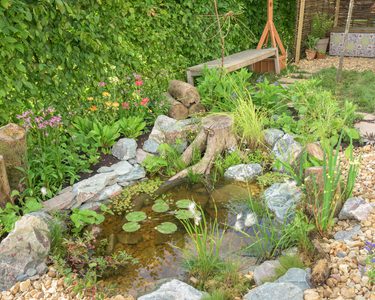How to take care of your pond this autumn

I hope you've enjoyed a great season of what we like to call ‘pondering’. Pond care has had its challenges this year with rain shortages, continuous warm weather and the inevitable algae blooms - but the beauty of a pond in the garden and the activity it brings has still been very enjoyable.
There's no doubt that, more than ever, the wildlife visiting your garden will have benefited from your pond. Wildlife ponds - those that feature gently sloping edges, native plants and no fish or pumps - offer a critical habitat for a wide range of creatures, from amphibians and invertebrates to birds and mammals.
During autumn, we need to think about some important pond care – and putting the time in now will pay you back next spring. An established and happy pond has an ecological balance that sustains clean water and an abundance of life. Insects and beneficial bacteria have been working hard all summer long digesting organic waste into healthy sediment.
In the coming months, we’ll start to see plant foliage die back in preparation for the winter months. This sudden influx of organic waste matter, combined with the addition of autumnal leaf fall, can quickly overwhelm a pond's natural system.
As the water cools the hard-working bacteria slow down, so the result can be a sudden build-up of unhealthy sludge and decay. This build-up is the root of most problems for the spring.
We can make the following interventions to help our ponds stay healthy, while still maintaining habitat spaces for the wildlife calling it home:
- Cut back marginal growth as it tires, but before it decays. We generally leave the sedges and rushes for winter structure and habitat, instead cutting these back in the spring when new shoots first start showing.
- Trim water lily flowers and foliage as soon as they yellow and before they sink and decay. These break down quickly and are then harder to remove, so catch them early. Long handled pond cutters are available to help, if you don't want to get into waders! Skim the pond surface of leaf debris as it falls, and removing any large build ups that have settled to the floor.
- Consider installing a cover net during the short leaf fall period. We always raise and pitch our nets towards the main direction of leaf fall, allowing continued safe passage for birds and wildlife. Generally, we advise removing the net once the leaf fall has finished to save any damage being caused and prolonging your pond for future seasons.
- Remove algae and blanket weed. It can continue to grow even during the colder months when you've taken your eyes off the pond, starting you off on the wrong foot next year.
- Rebuild log and rock piles around the pond for your amphibians to over winter. They appreciate the cover!
Always remember to have a good sift through whatever is removed from the pond for any small insect life. Leaving the debris on the pond side for a few days before composting will give an extra chance for anything to return to the water.
I hope you enjoy the last throws of activity in your pond this year. With these small changes, you can guarantee there will be plenty more to enjoy, come the spring.
WildWater Ponds are experts in wildlife-friendly ponds, streams and waterfalls that maximise nature and natural garden ecosystems. Find out more about them at www.wildwaterponds.co.uk and follow them on social media @wildwaterponds.